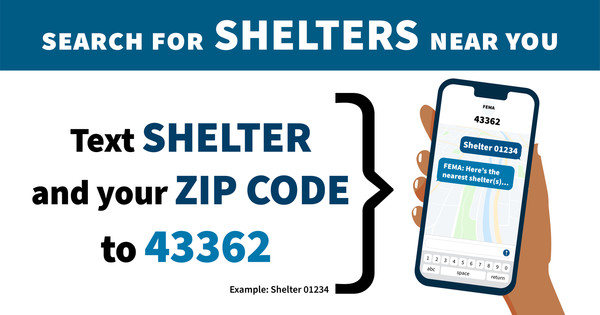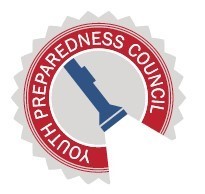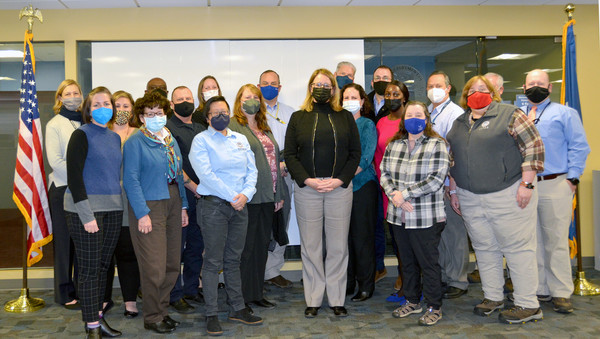|
Having the right information at the right time is often the key to surviving a disaster. FEMA’s updated texting feature allows the public to access shelter addresses when they need it most. Users can now text “shelter” and their ZIP code to 43362 to get a list of nearby shelter locations. This effort is made possible through collaboration with the American Red Cross.
“FEMA is always trying to find new ways we can make our country more resilient to disasters,” said FEMA Administrator Deanne Criswell. “We know that texting often works when other communications systems, such as the internet, are not functioning. Being able to find nearby shelter locations, especially under those conditions, will save lives.”
FEMA’s old text feature only showed shelters within the requested ZIP code. This new feature uses Geographic Information System (GIS) capabilities to give users shelter addresses within 200 miles of their ZIP code. The texting feature is accessible across all 50 states and U.S. territories. Standard texting rates with the user’s carrier may apply, but there is no additional fee to use this service. In phones with a standard map feature, users will be able to click on the shelter address inside the text message and view directions. The text can be easily shared with friends and family so they know where the user is going or where they themselves can take shelter.
Shelters identified through the text feature are pulled from data managed by the American Red Cross. FEMA does not run shelters. Furthermore, in a disaster situation it is always important to follow the immediate instructions of state and local officials, as they may be able to point survivors to additional shelters and resources not included in the text feature.
Disasters can strike anywhere, anytime. Save this number, 43362, in your phone today so you’ll be able to find a safe space to shelter during a disaster. Information on different types of shelters and sheltering can be found at Shelter | Ready.gov. Additional ways to find shelter can be found at FEMA.gov/Shelter or redcross.org/shelter.


FEMA is accepting applications for the Youth Preparedness Council. All applications are due no later than midnight on March 6. If you know a teen interested in preparedness and community service, encourage them to apply.
FEMA will host an applicant information session on Feb. 17 for those interested in learning more about the council and the application process. Help us spread the word about this year’s Youth Preparedness Council by using #YPC2022 on social media when sharing this news.
Members of the council work on projects that help increase preparedness in their communities. They share their opinions, experiences, ideas and solutions with FEMA leadership and participate in the annual Youth Preparedness Council summit.
We spoke to three members of the current council to find out more about their experiences. Visit the FEMA Blog to read their stories.
To learn more about the Youth Preparedness Council, visit Youth Preparedness Council | Ready.gov.
|
The Resilience Nation Partnership Network and the Department of Homeland Security’s Center for Faith-based and Neighborhood Partnerships is hosting this month’s “Ideation Hour” from 2 - 3:15 p.m. ET on Feb. 23. The event will explore and discuss the many factors behind strengthening climate equity for the whole community.
A part of the network's Resilience Exchange series, this freestyle event is open to everyone. Each participant is asked to bring your best resilience ideas, projects, needs and collaboration opportunities to share with others. The four topics for this session include:
- Building Climate Literacy: Where Do We Start?
- Fostering Resilience at the Neighborhood Level.
- Building Equity Into Mitigation Actions.
- Promoting Resilience Through Youth Engagement.
To register and for additional event information, visit Eventbrite.com. Contact FEMA-ResilientNation@fema.dhs.gov for questions.
FEMA published the architect resource type position. The architect resource type position provides architectural design and builds environmental professional support to emergency response and recovery operations.
Under this position qualification, an architect:
- Inspects and assesses impacted buildings and makes appropriate recommendations.
- Conducts building performance analysis.
- Supports temporary housing efforts, insurance documentation, local and state funding assistance applications, technical assistance and recovery planning.
For more information, including the full-scope of the Architect resource type definition, visit the Resource Typing Library Tool.
Resource typing is a key component of the National Incident Management System (NIMS) and enables organizations from across the country to work together during incidents of all types and sizes. Implementing NIMS resource management principles across the nation is a fundamental part of building our national preparedness.
FEMA is accepting requests for exercise support through the National Exercise Program. State, local, tribal and territorial partners can request no-cost assistance for exercise design, development, conduct and evaluation to validate capabilities across all mission areas.
FEMA is hosting webinars for all interested government and other community partners on the exercise support process.
Visit the webinar page to register. The webinar dates are:
- Webinar 1: 2 p.m. ET on Feb. 17.
- Webinar 2: 2 p.m. ET on Feb. 22.
- Webinar 3: 2 p.m. ET on Feb. 24.
- Webinar 4: 2 p.m. ET on March 1.
- Webinar 5: 2 p.m. ET on March 3.
- Webinar 6: 2 p.m. ET on March 8.
Spring 2022 requests for support are due no later than April 1. To submit a request for exercise support, download the support request form and email the completed form with supporting documentation to NEP@fema.dhs.gov. Awardees will be notified by May 6. FEMA will hold additional exercise support rounds in fall 2022 and spring 2023.
For questions, contact FEMA at NEP@fema.dhs.gov.
FEMA's Preparedness Toolkit is a suite of web-based tools that support a consistent approach to help communities implement resource management preparedness processes as defined in the National Incident Management System and the National Qualification System. Additionally, these resources support the 2022 – 2026 FEMA Strategic Plan Goal #3 – Promoting and Sustaining a Ready FEMA and Prepared Nation.
The suite includes OneResponder, the Resource Inventory Systems and the Resource Typing Library Tool. As of March, approximately 660 jurisdictions have adopted OneResponder and nearly 250 jurisdictions have adopted the Resource Inventory System.
The National Resource Hub helps emergency and incident managers implement NIMS resource management practices and the National Qualification System!
FEMA is hosting a National Resource Hub webinar series to walk users through the toolkit resources. The webinars will focus on the Resource Inventory System, OneResponder and the course equivalent tool.
Advance registration is required due to space limitations. To register, click on your preferred webinar session from the list below:
Resource Inventory System Introduction
OneResponder and Course Equivalency Tool Introduction
When Hurricane Ivan struck the Gulf Coast in 2004, it brought 10-15 feet high storm-surge to Alabama, Florida and Mississippi, leaving a trail of destruction. Ivan was one of four hurricanes to hit Florida, making 2004 a particular difficult year for the state.
Due to the catastrophic damage experienced, Emerald Coast Utilities Authority was facing one of its greatest challenges, providing clean, reliable wastewater treatment services for Escambia County, Florida, with a damaged facility and dated infrastructure. As a result of the storm, the utility authority's Main Street Wastewater Treatment Plant was offline for three-and-a-half days, flooding downtown Pensacola with a mix of storm water, storm surge and raw sewage.
When the waters receded, the utility's team found that there was severe rusting of the plant’s equipment and electrical components and knew that they had to act.
The wastewater plant had been constructed in 1937 and had struggled to meet the requirements of the Florida Department of Environmental Protection regulation. The facility was operating under multiple consent orders, mostly for pollution and odor control-related reasons.
In December 2002, the utility authority concluded that replacing the facility was the best way forward and construction of a new facility began in 2008.
In the aftermath of Hurricane Ivan, local officials began working with FEMA and through public outreach, they turned public opinion about upgrading the plant into an immediate priority.
The new facility, known as Central Water Reclamation Facility, provided better public health, strengthened the local economy, increased the quality of life, provided reliable water treatment services and strengthened private sector partnerships.
The success of the facility was demonstrated in 2020 when Hurricane Sally hit the area and the facility was left undamaged, providing continuous service for the area. Thanks to pre-planning, community involvement and actions taken by the local government, the utility authority was able to increase local resilience to coastal hazards.
For more information and to read the full case study and lessons learned from this disaster recovery, visit FEMA.gov.
On Feb. 8 and 9, FEMA’s National Continuity Programs hosted the biannual Regional Continuity Working Session, the first in-person session since the start of the COVID-19 pandemic.
These sessions bring together FEMA Regional Continuity Managers, representatives from the Pacific and Caribbean Area Offices and staff from FEMA headquarters to discuss topics related to continuity at all levels of government and across the whole community. Collectively these partners work together to support whole community partners in creating plans for sustaining critical services and functions when normal operations are disrupted.
FEMA Administrator Deanne Criswell and FEMA National Continuity Programs Directorate Assistant Administrator Michael George opened the session by outlining the strategic way ahead, priorities for the agency and ways the whole community continuity supports the goals for the agency.
Representatives from across FEMA as well as the Cybersecurity and Infrastructure Security Agency, the Office of Personnel Management and the city of Alexandria, Virginia, presented on topics in which the agency is leading efforts to build resilience.
Other topics discussed include:
- Supply chain risks in a post-pandemic world.
- FEMA Integration Team coordination with continuity programs.
- FEMA internal continuity planning updates.
- Future of the OPM Federal Executive Boards.
- Current threats and hazards environment.
To learn more about National Continuity Programs, participate in training, or find tools and resources related to continuity planning, visit FEMA.gov.
 FEMA Administrator Deanne Criswell with the Regional Continuity Working Session participants.
Firefighters Grants Application Deadline is Approaching
FEMA is accepting applications for the Fiscal Year 2021 grants that constitute the Assistance to Firefighters Grants program.
The application period is now open for $46 million in funding for the Fire Protection and Safety grants; it will close at 5 p.m. ET on Feb. 18. These grants focus on enhancing the safety of the public and firefighters with respect to fire and fire-related hazards.
The funding notice and technical assistance documents for this program will be available at grants.gov and FEMA.gov. For questions, contact FEMA's Fire Grants Helpdesk via email at firegrants@fema.dhs.gov.
…………………………………………………………………………………………………………..
FEMA Seeks New Members for National Advisory Council
FEMA is seeking qualified individuals to lend their expertise and serve on the agency’s National Advisory Council.
The National Advisory Council includes a geographically diverse and substantive cross-section of 35 members who advise the FEMA Administrator on all aspects of emergency management, ensuring input from and coordination with state, local, tribal and territorial governments as well as the private and nonprofit sectors. For more information about what each position entails, please see the council’s charter.
Individuals appointed to the council bring their experience and diversity of views to provide the administrator consensus recommendations on a broad range of issues.
If you are interested in applying to serve on the National Advisory Council, please follow the instructions found in the Federal Register for submitting an application package no later than midnight ET on March 31.
…………………………………………………………………………………………………………..
FEMA Seeks Public Comment to Enhance the Agency’s Programs
As part of its commitment to advance equity in underserved communities, FEMA proposes collecting of demographic information from applicants participating in certain FEMA programs.
Collecting this information will help FEMA ensure that people who apply for assistance are treated fairly and that FEMA programs comply with civil rights, nondiscrimination and equity requirements. Participation is voluntary. FEMA urges stakeholders, community groups and the public to comment on the information collection initiative.
The deadline to submit comments is March 28. Learn more and submit your comments on the Federal Register website.
…………………………………………………………………………………………………………..
FEMA Seeks Public Feedback on How-To Guide
FEMA is seeking public feedback on an updated "Emergency Operations Center (EOC) How-To Quick Reference Guide." The 30-day national engagement period opens today and will conclude at 5 p.m. ET March 1.
To provide comments on the drafts, complete the feedback form on the webpage and submit the form to fema-nims@fema.dhs.gov.
FEMA is hosting a series of webinars to aid jurisdictions with filling out the feedback form. Each stakeholder webinar will cover the same information, so choose the session most convenient for you.
Advance registration is required due to space limitations. Registration is on a first come, first served basis. To register, click on your preferred webinar session from the list below.
If you require accommodations to participate in these events, please provide details in the Disability Related Accommodations field on the registration page or contact FEMA-NIMS@fema.dhs.gov. Please make accommodation requests as early as possible; late requests will be accepted, but they may not be possible to fulfill.
…………………………………………………………………………………………………………..
|